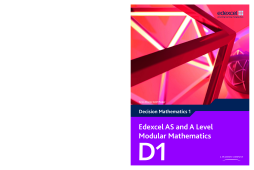
Additional Information
Book Details
Abstract
Edexcel and A Level Modular Mathematics D1 features:
- Student-friendly worked examples and solutions, leading up to a wealth of practice questions.
- Sample exam papers for thorough exam preparation.
- Regular review sections consolidate learning.
- Opportunities for stretch and challenge presented throughout the course.
- ‘Escalator section’ to step up from GCSE.
PLUS Free LiveText CD-ROM, containing Solutionbank and Exam Café to support, motivate and inspire students to reach their potential for exam success.
- Solutionbank contains fully worked solutions with hints and tips for every question in the Student Books.
- Exam Café includes a revision planner and checklist as well as a fully worked examination-style paper with examiner commentary.
Table of Contents
| Section Title | Page | Action | Price |
|---|---|---|---|
| Cover | Cover | ||
| Contents | ii | ||
| About this book | iv | ||
| Chapter 1: Algorithms | 1 | ||
| 1.1: Understanding and using an algorithm given in words | 2 | ||
| 1.2: Implementing an algorithm given in the form of a flow chart | 5 | ||
| 1.3: Carrying out a bubble sort | 10 | ||
| 1.4: Carrying out a quick sort | 12 | ||
| 1.5: Implementing a binary search | 14 | ||
| 1.6: Implementing the three bin packing algorithms and being aware of their limitations | 17 | ||
| Summary of key points | 24 | ||
| Chapter 2: Graphs and networks | 25 | ||
| 2.1: Knowing how graphs and networks can be used to create mathematical models | 26 | ||
| 2.2: Being familiar with some basic terminology used in graph theory | 28 | ||
| 2.3: Knowing some special types of graph | 32 | ||
| 2.4: Understanding how graphs and networks can be represented using matrices | 34 | ||
| Summary of key points | 38 | ||
| Chapter 3: Algorithms on networks | 40 | ||
| 3.1: Using Kruskal’s algorithm to find a minimum spanning tree | 41 | ||
| 3.2: Using Prim’s algorithm on a network to find a minimum spanning tree | 45 | ||
| 3.3: Applying Prim’s algorithm to a distance matrix | 47 | ||
| 3.4: Using Dijkstra’s algorithm to find the shortest path between two vertices in a network | 51 | ||
| Summary of key points | 61 | ||
| Chapter 4: Route inspection (Chinese postman problem) | 63 | ||
| 4.1: Determining whether a graph is traversable | 64 | ||
| 4.2: Using the route inspection algorithm to find the shortest route in a network | 67 | ||
| Summary of key points | 76 | ||
| Review Exercise 1 | 77 | ||
| Chapter 5: Critical path analysis | 87 | ||
| 5.1: Modelling a project by an activity network, from a precedence table | 88 | ||
| 5.2: Understanding the use of dummies | 92 | ||
| 5.3: Carrying out a forward pass and a backward pass using early and late event times | 96 | ||
| 5.4: Identifying critical activities | 98 | ||
| 5.5: Determining the total float of activities | 101 | ||
| 5.6: Constructing cascade (Gantt) charts | 102 | ||
| 5.7: Using cascade (Gantt) charts | 104 | ||
| 5.8: Constructing a scheduling diagram | 105 | ||
| Summary of key points | 112 | ||
| Chapter 6: Linear programming | 113 | ||
| 6.1: Formulating a problem as a linear programming problem | 114 | ||
| 6.2: Illustrating a two-variable linear programming problem graphically | 121 | ||
| 6.3: Locating the optimal point in a feasible region using the objective line (ruler) method | 127 | ||
| 6.4: Using the vertex testing method to locate the optimal point | 135 | ||
| 6.5: Determining solutions that need integer values | 141 | ||
| Summary of key points | 148 | ||
| Chapter 7: Matchings | 149 | ||
| 7.1: Modelling matching problems using a bipartite graph | 150 | ||
| 7.2: Using the maximum matching algorithm, starting from an initial matching | 153 | ||
| Summary of key points | 161 | ||
| Review Exercise 2 | 162 | ||
| Examination style paper | 173 | ||
| Answers | 177 | ||
| Index | 232 |
